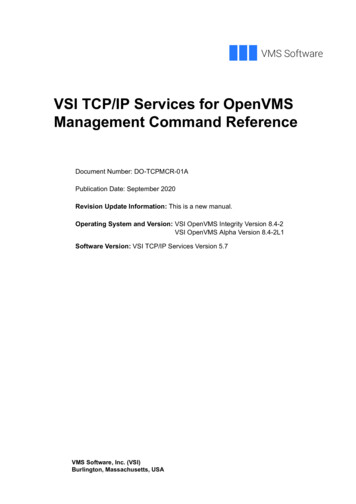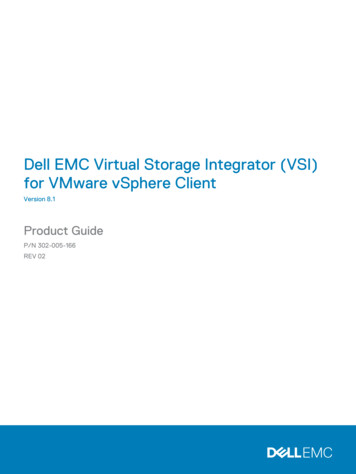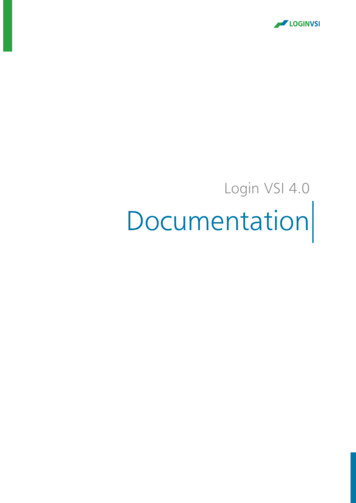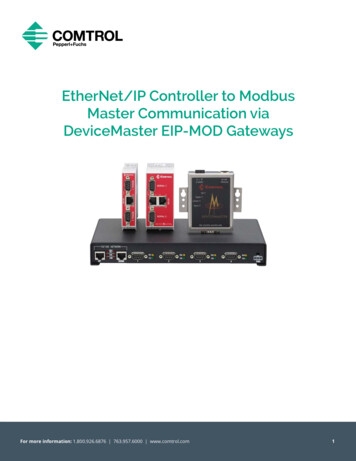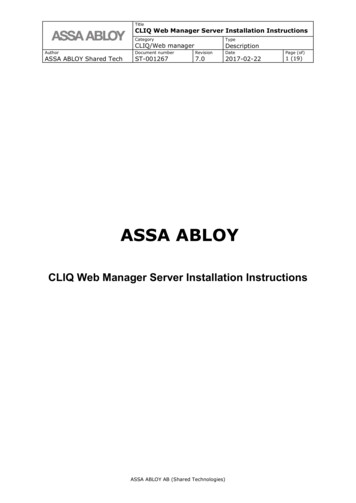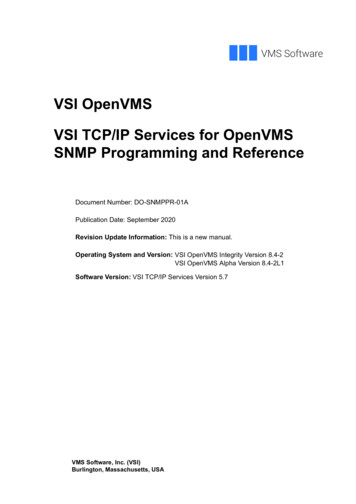
Transcription
VSI OpenVMSVSI TCP/IP Services for OpenVMSSNMP Programming and ReferenceDocument Number: DO-SNMPPR-01APublication Date: September 2020Revision Update Information: This is a new manual.Operating System and Version: VSI OpenVMS Integrity Version 8.4-2VSI OpenVMS Alpha Version 8.4-2L1Software Version: VSI TCP/IP Services Version 5.7VMS Software, Inc. (VSI)Burlington, Massachusetts, USA
VSI TCP/IP Services for OpenVMS SNMP Programming and ReferenceCopyright 2020 VMS Software, Inc. (VSI), Burlington, Massachusetts, USALegal NoticeConfidential computer software. Valid license from VSI required for possession, use or copying. Consistent with FAR 12.211 and 12.212,Commercial Computer Software, Computer Software Documentation, and Technical Data for Commercial Items are licensed to the U.S.Government under vendor's standard commercial license.The information contained herein is subject to change without notice. The only warranties for VSI products and services are set forth in theexpress warranty statements accompanying such products and services. Nothing herein should be construed as constituting an additionalwarranty. VSI shall not be liable for technical or editorial errors or omissions contained herein.HPE, HPE Integrity, HPE Alpha, and HPE Proliant are trademarks or registered trademarks of Hewlett Packard Enterprise.Intel, Itanium and IA-64 are trademarks or registered trademarks of Intel Corporation or its subsidiaries in the United States and othercountries.UNIX is a registered trademark of The Open Group.The VSI OpenVMS documentation set is available on DVD.ii
VSI TCP/IP Services for OpenVMS SNMP Programming and ReferencePreface . v1.2.3.4.5.6.About VSI . vIntended Audience . vDocument Structure . vRelated Documents . viVSI Encourages Your Comments . viiConventions . viiChapter 1. Overview . 11.1.1.2.1.3.1.4.1.5.SNMP Architecture . 1Request Handling . 2TCP/IP Services Components for SNMP . 4Writing an eSNMP Subagent . 5The eSNMP API . 61.5.1. The SNMP Utilities . 71.6. The MIB Compiler . 71.7. SNMP Versions . 81.7.1. Using Existing (SNMP Version 1) MIB Modules . 81.8. For More Information . 9Chapter 2. MIBs Provided with TCP/IP Services . 112.1. Overview of the Host Resources MIB .2.1.1. Defining Host Resources MIB Implemented Objects .2.1.2. Restrictions to Host Resources MIB .2.2. Overview of MIB II .2.2.1. MIB II Implemented Groups .2.2.2. Restrictions to MIB II Implementation .111113161616Chapter 3. Creating a Subagent Using the eSNMP API . 193.1. Creating a MIB Specification . 193.2. The Structure of Management Information . 193.2.1. Assigning Object Identification Codes . 193.2.2. MIB Subtrees . 203.3. Creating a MIB Source File . 223.3.1. Writing the ASN.1 Input File . 223.3.2. Processing the Input File with the MIB Compiler . 233.4. Including the Routines and Building the Subagent . 293.5. Including Extension Subagents in the Startup and Shutdown Procedures . 30Chapter 4. Using the SNMP Utilities . 334.1. Using the MIB Browser .4.1.1. MIB Browser Parameters .4.1.2. MIB Browser Flags .4.1.3. MIB Browser Data Types .4.1.4. Command Examples for snmp request .4.2. Using the Trap Sender and Trap Receiver Programs .4.2.1. Entering Commands for the Trap Sender Program .4.2.2. Entering Commands for the Trap Receiver Program .3333343738414145Chapter 5. eSNMP API Routines . 475.1.5.2.5.3.5.4.Interface Routines .Method Routines .Processing * set Routines .Method Routine Applications Programming .47606466iii
VSI TCP/IP Services for OpenVMS SNMP Programming and Reference5.5. Value Representation . 675.6. Support Routines . 68Chapter 6. Troubleshooting eSNMP Problems . 936.1. Modifying the Subagent Error Limit . 936.2. Modifying the Subagent Timeout . 936.3. Log Files . 94iv
PrefaceThe VSI TCP/IP Services for OpenVMS product is the VSI implementation of the TCP/IP networkingprotocol suite and internet services for OpenVMS Alpha and OpenVMS VAX systems.A layered software product, TCP/IP Services provides a comprehensive suite of functions andapplications that support industry-standard protocols for heterogeneous network communications andresource sharing.This manual describes the features of the Simple Network Management Protocol (SNMP) providedwith TCP/IP Services. It also describes the extensible SNMP (eSNMP) application programminginterface (API)and development environment.See the VSI TCP/IP Services for OpenVMS Installation and Configuration manual for informationabout installing, configuring, and starting this product.1. About VSIVMS Software, Inc., (VSI) is an independent software company licensed by Hewlett PackardEnterprise to develop and support the OpenVMS operating system.VSI seeks to continue the legendary development prowess and customer-first priorities that are soclosely associated with the OpenVMS operating system and its original author, Digital EquipmentCorporation.2. Intended AudienceThis manual is for experienced OpenVMS and UNIX system managers and assumes a workingknowledge of TCP/IP networking, TCP/IP terminology, and some familiarity with the TCP/IPServices product.3. Document StructureThis manual contains the following chapters: Chapter 1 describes the implementation of eSNMP provided with TCP/IP Services. Chapter 2 describes the groups and objects implemented with the Host Resources MIB and MIB IIthat are provided with the eSNMP software. Chapter 3 describes how to use the eSNMP API to create a MIB subagent to manage entities orapplications. Chapter 4 describes the trap sender, trap receiver,and MIB browser utilities provided with TCP/IPServices. Chapter 5 provides reference information about the eSNMP API routines. Chapter 6 describes some troubleshooting aids provided with TCP/IP Services.v
Preface4. Related DocumentsThe table below lists the documents available with this version of TCP/IP Services.Table 1. TCP/IP Services DocumentationManualContentsVSI TCP/IP Services for OpenVMS Conceptsand PlanningThis manual provides conceptual informationabout TCP/IP networking on OpenVMSsystems,including general planning issues toconsider before configuring your system to usethe TCP/IP Services software.This manual also describes the manuals in thedocumentation set,and provides a glossary ofterms and acronyms for the TCP/IP Servicessoftware product.VSI TCP/IP Services for OpenVMS ReleaseNotesThe release notes provide version-specificinformation that supersedes the information inthe documentation set. The features,restrictions,and corrections in this version of the software aredescribed in the release notes. Always read therelease notes before installing the software.VSI TCP/IP Services for OpenVMS Installationand ConfigurationThis manual explains how to install and configurethe TCP/IP Services product.VSI TCP/IP Services for OpenVMS User’s Guide This manual describes how to use the applicationsavailable with TCP/IP Services such as remotefile operations, email, TELNET, TN3270, andnetwork printing.VSI TCP/IP Services for OpenVMS Management This manual describes how to configure andmanage the TCP/IP Services product.VSI TCP/IP Services for OpenVMS Management This manual describes the TCP/IP ServicesCommand Referencemanagement commands.VSI TCP/IP Services for OpenVMS Management This reference card lists the TCP/IP managementCommand Quick Reference Cardcommands by component and describes thepurpose of each command.VSI TCP/IP Services for OpenVMS UNIXCommand Equivalents Reference CardThis reference card contains information aboutcommonly performed network management tasksand their corresponding TCP/IP management andUNIX command formats.VSI TCP/IP Services for OpenVMS ONC RPCProgrammingThis manual presents an overview of high-levelprogramming using open network computingremote procedure calls (ONC RPC). This manualalso describes the RPC programming interfaceand how to use the RPCGEN protocol compiler tocreate applications.VSI TCP/IP Services for OpenVMS Guide toSSHThis manual describes how to configure, setup, use, and manage the SSH for OpenVMSsoftware.vi
PrefaceManualContentsVSI TCP/IP Services for OpenVMS Sockets API This manual describes how to use the Socketsand System Services ProgrammingAPI and OpenVMS system services to developnetwork applications.VSI TCP/IP Services for OpenVMS SNMPProgramming and ReferenceThis manual describes the Simple NetworkManagement Protocol (SNMP) and the SNMPapplication programming interface (eSNMP).It describes the subagents provided with TCP/IP Services, utilities provided for managingsubagents, and how to build your own subagents.VSI TCP/IP Services for OpenVMS Tuning andTroubleshootingThis manual provides information about how toisolate the causes of network problems and howto tune the TCP/IP Services software for the bestperformance.VSI TCP/IP Services for OpenVMS Guide toIPv6This manual describes the IPv6 environment, theroles of systems in this environment, the typesand function of the different IPv6addresses, andhow to configure TCP/IP Services to access theIPv6 network.For a comprehensive overview of the TCP/IP protocol suite, refer to the book Internetworking withTCP/IP:Principles, Protocols, and Architecture, by Douglas Comer.5. VSI Encourages Your CommentsYou may send comments or suggestions regarding this manual or any VSI document by sendingelectronic mail to the following Internet address: docinfo@vmssoftware.com . Users whohave OpenVMS support contracts through VSI can contact support@vmssoftware.com forhelp with this product. Users who have OpenVMS support contracts through HPE should contact theirHPE Support channel for assistance.6. ConventionsVMScluster systems are now referred to as OpenVMS Cluster systems. Unless otherwise specified,references to OpenVMS Cluster systems or clusters in this document are synonymous withVMScluster systems.The contents of the display examples for some utility commands described in this manual may differslightly from the actual output provided by these commands on your system. However, when thebehavior of a command differs significantly between OpenVMS Alpha and Integrity servers, thatbehavior is described in text and rendered, as appropriate, in separate examples.In this manual, every use of DECwindows and DECwindows Motif refers to DECwindows Motif forOpenVMS software.The name TCP/IP Services means any of the following: VSI TCP/IP Services for OpenVMS I64 VSI TCP/IP Services for OpenVMS Alphavii
Preface VSI TCP/IP Services for OpenVMS VAXIn addition,please note that all IP addresses are fictitious.The following conventions are also used in this manual:ConventionMeaningCtrl/ xA sequence such as Ctrl/ x indicates that you must hold down the key labeledCtrl while you press another key or a pointing device button.PF1 xA sequence such as PF1 x indicates that you must first press and release the keylabeled PF1 and then press and release another key or a pointing device button.ReturnIn examples, a key name enclosed in a box indicates that you press a key on thekeyboard. (In text, a key name is not enclosed in a box.) A horizontal ellipsis in examples indicates one of the following possibilities:. Additional optional arguments in a statement have been omitted. The preceding item or items can be repeated one or more times. Additional parameters, values, or other information can be entered.A vertical ellipsis indicates the omission of items from a code example orcommand format; the items are omitted because they are not important to thetopic being discussed.()In command format descriptions, parentheses indicate that you must enclose theoptions in parentheses if you choose more than one.[]In command format descriptions, brackets indicate optional choices. You canchoose one or more items or no items. Do not type the brackets on the commandline. However, you must include the brackets in the syntax for OpenVMSdirectory specifications and for a substring specification in an assignmentstatement.[ ]In command format descriptions, vertical bars separate choices within bracketsor braces. Within brackets, the choices are options; within braces, at least onechoice is required. Do not type the vertical bars on the command line.{}In command format descriptions, braces indicate required choices; you mustchoose at least one of the items listed. Do not type the braces on the commandline.bold textThis typeface represents the introduction of a new term. It also represents thename of an argument, an attribute, or a reason.italic textItalic text indicates important information, complete titles of manuals, orvariables. Variables include information that varies in system output (Internalerror number), in command lines (/PRODUCER name), and in commandparameters in text (where dd represents the predefined code for the device type).UPPERCASETEXTUppercase text indicates a command, the name of a routine, the name of a file,or the abbreviation for a system privilege.MonospacetypeMonospace type indicates code examples and interactive screen displays.viiiIn the C programming language, monospace type in text identifies the followingelements: keywords, the names of independently compiled external functions
PrefaceConventionMeaningand files, syntax summaries, and references to variables or identifiers introducedin an example.-A hyphen at the end of a command format description, command line, or codeline indicates that the command or statement continues on the following line.numbersAll numbers in text are assumed to be decimal unless otherwise noted.Nondecimal radixes—binary, octal, or hexadecimal—are explicitly indicated.Other conventions are: All numbers are decimal unless otherwise noted. All Ethernet addresses are hexadecimal.ix
Prefacex
Chapter 1. OverviewThe Simple Network Management Protocol (SNMP) is the de facto industry standard for managingTCP/IP networks. The protocol defines the role of a network management station (NMS) and theSNMP agent. SNMP allows remote users on an NMS to monitor and manage network entities such ashosts, routers, X terminals, and terminal servers.TCP/IP Services provides support for SNMP Version 2, using the Extensible Simple NetworkManagement Protocol (eSNMP) architecture, under which a single master agent can support anynumber of subagents. The TCP/IP Services implementation of eSNMP includes a master agent, twosubagents, an application programming interface (API), tools used to build additional subagents,startup and shutdown procedures, and text-based configuration files.This chapter provides an overview of the VSI OpenVMS implementation of eSNMP. Topics include: eSNMP master agent and subagent architecture (Section 1.1) The procedure for handling SNMP requests (Section 1.2) The components of the TCP/IP Services software kit that implement SNMP (Section 1.3) The files useful in developing your own subagent (Section 1.4) The eSNMP API (Section 1.5) The management information base (MIB) compiler (Section 1.6) The impact of running SNMP Version 1 subagents against the SNMP Version 2 implementationprovided with TCP/IP Services (Section 1.7) Sources of additional information about implementing subagents (Section 1.8)1.1. SNMP ArchitectureFigure 1.1 illustrates the SNMP architecture.Figure 1.1. SNMP ArchitectureThe SNMP environment consists of the following elements:1
Chapter 1. Overview The master agent, a process that runs on the host and handles SNMP requests from clients over thestandard SNMP well-known port 161. One or more subagents, each of which provides access to the MIB data specified in client requests.In the TCP/IP Services implementation, the master agent contains two resident subagents, one thathandles a subset of MIB II variables, and another that handles the Host Resources MIB. TheseMIBs are described in Chapter 2. The SNMP ASN.1 library, used by the master agent to interpret ASN.1 messages. The eSNMP API, the application programming interface that provides routines for programmingyour own subagents. This API runs on the AgentX routines, which are internal to the SNMParchitecture. The TCP/IP kernel running on the OpenVMS operating system.The master agent and subagents communicate by means of the AgentX protocol, which is basedon RFC 2741.For information about configuring and managing the SNMP service, refer to the VSI TCP/IP Servicesfor OpenVMS Management guide.1.2. Request HandlingThe eSNMP software manages network communication by having the master agent listen for requestsand then passes the requests to the appropriate subagent.Figure 1.2 illustrates communication between the master agent and subagents.Figure 1.2. eSNMP Data FlowThe process of communication for a request is illustrated with dashed lines and includes the followingsteps:2
Chapter 1. Overview1. The network management station (NMS) (sometimes called the client), originates SNMP requeststo obtain and set information.NoteThe client component is not provided with TCP/IP Services.To provide access to MIBs and to test SNMP communication, TCP/IP Services provides the followingutilities: MIB browser Trap sender Trap receiverThese utilities are described in Chapter 4.The network management station sends an SNMP request to the master agent running on the host,using port 161. An SNMP request is made using one of the following commands: Get GetNext GetBulk SetNoteTCP/IP Services does not support the standard SNMP Inform command.The request specifies the object identifier (OID) of the data to be accessed. For information aboutformatting get and set requests, refer to Section 5.2. Request formats are specified in RFC1905.2. The master agent sends the request to the subagent that registered the subtree containing the OID.The subagent receives communications from the master agent over the socket that was assignedwhen the subagent registered the subtree.3. The appropriate subagent processes the request.4. The subagent sends the response message to the master agent using the port that was assignedwhen the subagent registered the MIB.When they are idle, subagents periodically send a message to port 705 to ensure that the master agentis still running. In Figure 1.2, subagent 1 is sending the esnmp are you there message.A trap is generated by the subagent and sent to the client. In Figure 1.2, subagent n is generating atrap for the trap client on NMS 2.The trap and esnmp are you there routines are described in Section 5.1.3
Chapter 1. Overview1.3. TCP/IP Services Components for SNMPTable 1.1 lists the components of SNMP and the command procedures for managing SNMP that aresupplied with TCP/IP Services.Table 1.1. SNMP Component FilesFileLocationFunctionTCPIP ESNMP SERVER.EXE SYS SYSTEMMaster agent image.TCPIP OS MIBS.EXESYS SYSTEMMIB II subagent image.TCPIP HR MIB.EXESYS SYSTEMHost Resources MIB subagentimage.TCPIP SNMP REQUEST.EXE SYS SYSTEMSimple MIB browser.TCPIP SNMP TRAPSND.EXE SYS SYSTEMUtility for sending trapmessages.TCPIP SNMP TRAPRCV.EXE SYS SYSTEMUtility for receiving trapmessages.TCPIP ESNMP SHR.EXEImage file containing eSNMPapplication programminginterface (API) routines.SYS SHARETCPIP SNMP STARTUP.COM SYS STARTUPCommand procedure thatinstalls master and subagentimages and runs TCPIP SNMP RUN.COM.TCPIP SNMP SYSTARTUP.COMSYS STARTUPCommand procedureinitiated by TCPIP SNMP STARTUP.COM.Provided for site-specificcustomizations, such asparameter settings.TCPIP SNMP RUN.COMTCPIP SYSTEMCommand procedure that startsthe master agent and subagents.TCPIP SNMP SHUTDOWN.COMSYS STARTUPCommand procedure that stopsthe master agent and subagents.TCPIPSYS STARTUP SNMP SYSHUTDOWN.COMTCPIP EXTENSION MIBSTARTUP.COMCommand procedureinitiated by TCPIP SNMP SHUTDOWN.COM.Provided for site-specificcustomization, such as parametersettings.SYS SYSDEVICE:[TCPIP SNMP]Command procedureinvoked by TCPIP SNMP SYSTARTUP.COM tostart custom subagents.4
Chapter 1. OverviewFileLocationTCPIP EXTENSION MIBSYS SYSDEVICE:[TCPIP SNMP]SHUTDOWN.COMFunctionCommand procedureinvoked by TCPIP SNMP SYSHUTDOWN.COMto stop custom subagents.TCPIP EXTENSIONMIB RUN.COMSYS SYSDEVICE:[TCPIP SNMP]Command procedureinvoked by TCPIP SNMP SYSTARTUP.COMwhen the service is enabled andstarts detached processes to runsubagents.1.4. Writing an eSNMP SubagentTable 1.2 lists the files that are available to help you develop MIBs and subagents. Except wherenoted, the files are located in the directory pointed to by TCPIP SNMP EXAMPLES.Table 1.2. Files for Building a SubagentFileDescriptionESNMP.HHeader file used to create a subagent. Located inTCPIP ESNMP.GAWK.EXEInterpreter for MIB converter.MIB-CONVERTER.AWKA UNIX based awk shell script that takes a MIBdefinition in ASN.1 notation and converts it toan .MY file.RFC1213.MYMIB II definitions.RFC1231.MYIEEE 802.5 Token Ring MIB definitions.RFC1285.MYFDDI MIB definitions.RFC1442.MYSNMP Version 2 Structure of ManagementInformation (SMI) definitions.SNMP-SMI.MYSNMP Version 2 SMI definitions from RFC 1902(replaces RFC 1442).SNMP-TC.MYSNMP Version 2 SMI definitions from RFC 1903(replaces RFC 1443).V2-TC.MYSNMP Version 2 SMI definitions from RFC 1903(superset of those in SNMP-TC.MY).TCPIP BUILD CHESS.COMCommand file that builds the sample chesssubagent.TCPIP CHESS SUBAGENT.OPTOptions file for use in building the sample chesssubagent.5
Chapter 1. OverviewFileDescription*.C and *.HSource code for chess example. Contains detaileddocumentation that explains how the codefunctions.TCPIP CHESS SUBAGENT.EXEFunctioning chess example image.TCPIP ESNMP.OLBObject library file containing routines usedto create a subagent. Located in the directorypointed to by TCPIP SNMP.TCPIP ESNMP SHR.EXEShareable image containing routines used tocreate a subagent. Located in the directorypointed to by SYS SHARE.UCX ESNMP SHR.EXECopy of TCPIP ESNMP SHR.EXE, providedfor compatibility with existing customersubagents linked under TCP/IP Services V4.x. Located in the directory pointed to by SYS SHARE.TCPIP MIBCOMP.EXEImages associated with the MIB compiler.Located in SYS SYSTEM.TCPIP MOSY.EXETCPIP SNMPI.EXEFor information about building a subagent on an OpenVMS system, see Chapter 3.1.5. The eSNMP APIThe TCP/IP Services implementation of the eSNMP architecture includes an API that providesprogrammers with many eSNMP routines they would otherwise have to develop themselves.The eSNMP API includes interface routines, method routines, and support routines.Interface routines handle the basic subagent operations, such as: Subagent initialization and termination Registration Polling of the master agent Trap sending UNIX system time conversion Adding and removing subagent capabilities registered with the master agentThe support routines allow the subagent to manipulate the data in the response to the request, andinclude the following: Basic protocol data unit (PDU) handling Authentication handling6
Chapter 1. Overview Octet string handling Variable binding (VARBIND) handling Object identifier (OID) handling Buffer handlingChapter 5 describes the API routines in more detail.To create a subagent, the programmer must provide modules to implement the method routines, asdescribed in Chapter 3.1.5.1. The SNMP UtilitiesTo provide quick access to information in the MIBs, and to test SNMP operation, TCP/IP Servicesprovides the following utilities: TCPIP SNMP REQUEST.EXE, a MIB browser that allows you to retrieve and update objectsfrom the MIBs. TCPIP SNMP TRPSND.EXE, a trap sender that generates traps (messages that require noresponse). TCPIP SNMP TRPRCV.EXE, a trap receiver (or “listener”) that is used to detect trap messages.For information about using the SNMP utilities, see Chapter 4.1.6. The MIB CompilerThe MIB compiler processes the statements in an ASN.1 file and generates modules that are usedby the developer to create subagent routines. For every ASN.1 input file that is processed using theMIB compiler, two output files, a subtree TBL.H file and a subtree TBL.C file, are generated, wheresubtree is the name from the original MIB definition file (for example, chess). The output files aredescribed in more detail in Chapter 3.The subtree TBL.H file is a header file that contains the following: A declaration of the subtree structure Index definitions for each MIB variable in the subtree Enumeration definitions for MIB variables with enumerated values MIB group data structure definitions Method routine function prototypesThe subtree TBL.C file is an object file that contains the following: An array of integers representing the OIDs for each MIB variable An array of OBJECT structures An initialized SUBTREE structure7
Chapter 1. Overview1.7. SNMP VersionsThe extensible SNMP software supports SNMP Version 2, based on RFCs 1901 through 1908,including: The SNMP Version 2 structure of management information for SNMP Version 2 (SMI Version 2)and textual conventions. The eSNMP library API (SNMP Version 2), variable binding exceptions, and error codes. SNMP Version 1 and SNMP Version 2 requests. Both versions are handled by the master agent.SNMP Version 2 specific information from the subagent is mapped, when necessary, to SNMPVersion 1 adherent data (according to RFC 2089). For example, if a management applicationmakes a request using SNMP Version 1 PDUs, the master agent replies using SNMP Version1 PDUs, mapping any SNMP Version 2 SMI items received from subagents. In most cases,subagents created with a previous version of the eSNMP API do not require any code changesand do not have to be recompiled. The circumstances under which recoding or recompiling arerequired are d
This manual describes the features of the Simple Network Management Protocol (SNMP) provided with TCP/IP Services. It also describes the extensible SNMP (eSNMP) application programming interface (API)and development environment. See the VSI TCP/IP Services for OpenVMS Installation and Configuration manual for information
